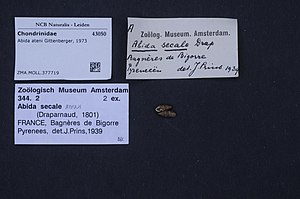Abida ateni
| Abida ateni | ||||||||||||
|---|---|---|---|---|---|---|---|---|---|---|---|---|

Abida ateni |
||||||||||||
| Systematics | ||||||||||||
|
||||||||||||
| Scientific name | ||||||||||||
| Abida ateni | ||||||||||||
| Gittenberger , 1973 |
Abida ateni is a type of grain snail (Chondrinidae) from the suborder of land snails (Stylommatophora). The taxon was originally described as a subspecies and only recognized as a separate species in 2010. The species name honors the Dutch collector D. Aten, who collected the holotype.
features
The spindle-shaped, rather compact case is 5.8 to 6.9 mm high and 2.2 to 2.6 mm wide. It has 7.5 to 8 slightly to moderately curved turns. The surface is very regularly and finely striped. At the mouth edge there is a strongly thickened white lip on the inside, but it is not swell-shaped. The mouth edges are connected to each other in the parietal area by a weak to moderately strong callus. The mouth reinforcement has up to 12 teeth. The spiral is connected to the angular. A weak subangularis runs parallel to this. In addition to the parietalis, an infraparietalis is also occasionally formed. Columellaris and infracolumellaris extend very far forward; the columellaris is somewhat thicker than the infracolumellaris. Often there is also a basalis that is about the same thickness as the infracolumellaris. According to its location, it could also be called a columella fold. The infrapalatalis and the inferior palatalis are simple and extend to the edge of the mouth. The superior palatalis is occasionally and only vaguely developed as a double hump and also extends to the edge of the mouth. There is also a more or less strong suprapalatalis. The last turn of the case is flattened crookedly, but not narrowed. The base is also only slightly keeled. The neck of the case is not dented. The edge of the mouth of the mouth is slightly bent backwards in the side view. When viewed from below, it cannot or can hardly be seen.
In the male part of the genital apparatus, the penis and epiphallus are fused together in the lower penis area and form a loop. The free penis, i.e. H. the area between the atrium and the point of adhesion with the epiphallus is comparatively long. The penis is roughly twice as long as the epiphallus. The penis / epiphallus transition is slightly below the bend (towards the epiphallus). In the upper part of the free penis, the seminal duct is embedded in the tissue of the penis. The penile retractor muscle inserts on the first quarter to fifth of the loop. The vagina is one and a half to three times as long as the "free" penis. It is also significantly longer than the free fallopian tube. The seminal vesicle (spermathec) is elongated, the stalk is very long and not embedded in the tissue of the prostate gland. As a result, the seminal vesicle comes to lie at the level of the albumin gland. At the branch with the free fallopian tube, the stalk is about two and a half times as thick as the free fallopian tube.
In the radula there are 20 to 22 posterior teeth in a semi-transverse row next to the central tooth. The central tooth has secondary peaks; but these can also be missing; d. H. the central tooth has no secondary peaks.
Similar species
Abida ateni differs from the rye grain snail ( Abida secale ) in its shell, which looks more like a Chondrina species. The casing has comparatively few turns and the inferior palatalis and infrapalatalis are not designed as double humps.
Geographical distribution and habitat
The distribution area of the species is limited to the Aspe valley ("Vallée d'Aspe") in the Pyrénées-Atlantiques department in the French western Pyrenees. Overall, the area is only about 11 km², the species only occurs in three (known) locations. It comes there between 300 m and 400 m height. The species lives on limestone rocks.
Taxonomy
The taxon was established in 1973 by Edmund Gittenberger as the subspecies Abida secale ateni . Already Gittenberger found no transitions to other subspecies of Abida secale . Bas Kokshoorn and Edmund Gittenberger then treated the taxon as a separate species in 2010. Fauna Europaea followed this view. According to the molecular genetic data published by Kokshoorn and Gittenberger, Abida ateni is the sister taxon of Abida vergniesiana .
Danger
According to the assessment of the International Union for Conservation of Nature and Natural Resources (IUCN), the species is endangered due to its very small distribution area. Even the construction of quarries or the widening of roads could endanger the few occurrences of the species.
supporting documents
literature
- Edmund Gittenberger: Contributions to the knowledge of the pupillacea: III. Chondrininae. Zoologische Verhandelingen, 127 (1): 3-267, 1973 ISSN 0024-1652 PDF (pp. 128-132.).
- Bas Kokshoorn, Edmund Gittenberger: Chondrinidae taxonomy revisited: New synonymies, new taxa, and a checklist of species and subspecies (Mollusca: Gastropoda: Pulmonata). Zootaxa, 2539: 1–62, 2010 Preview (PDF; 22 kB)
- Francisco W. Welter-Schultes: European non-marine molluscs, a guide for species identification = identification book for European land and freshwater mollusks. A1-A3 S., 679 S., Q1-Q78 S., Göttingen, Planet Poster Ed., 2012 ISBN 3-933922-75-5 , ISBN 978-3-933922-75-5
Individual evidence
- ↑ Gittenberger (1973: pp. 122–125)
- ^ Fauna Europaea: Abida ateni Gittenberger 1973
- ↑ Gargominy, O. 2011. Abida ateni. In: IUCN 2013. IUCN Red List of Threatened Species. Version 2013.1. <www.iucnredlist.org>. Retrieved September 22, 2013.